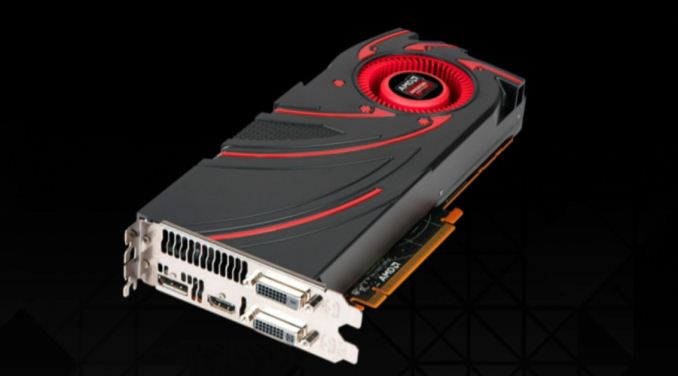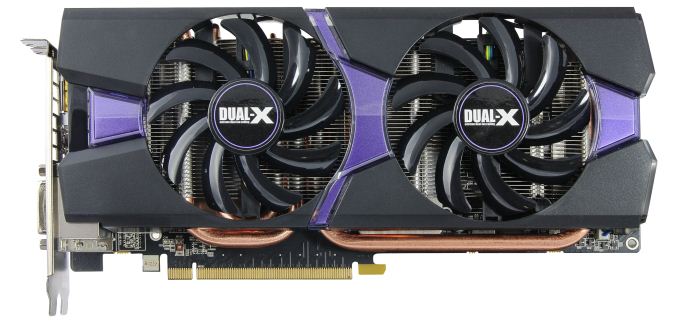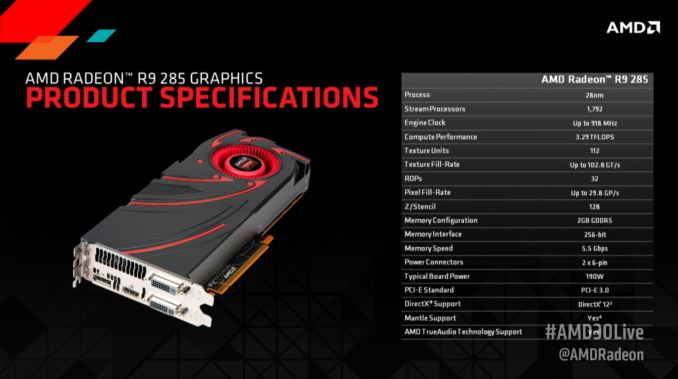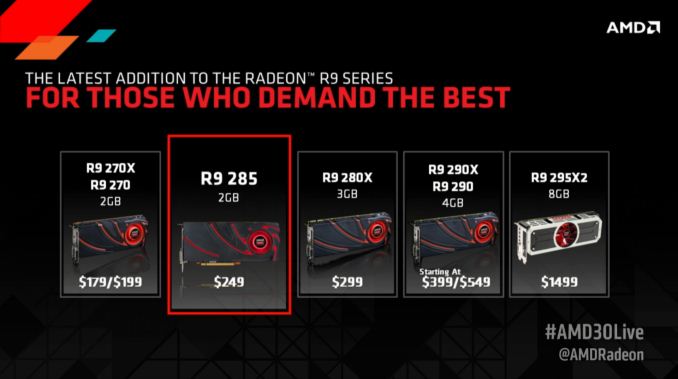AMD Announces Radeon R9 285, Shipping September 2nd
by Ryan Smith on August 23, 2014 7:00 PM EST
During their 30 years of graphics celebration, today AMD announced a forthcoming addition to the Radeon R9 200 graphics card lineup. Launching on September 2nd will be the company’s new midrange enthusiast card, the Radeon R9 285.
The R9 285 will take up an interesting position in AMD’s lineup, being something of a refresh of a refresh that spans all the way back to Tahiti (Radeon 7970). Spec wise it ends up being extremely close on paper to the R9 280 (née 7950B) and it’s telling that the R9 280 is no longer being advertised by AMD as a current member of their R9 lineup. However with a newer GPU under the hood the R9 285 stands to eclipse the 280 in features, and with sufficient efficiency gains we hope to see it eclipse 280 in performance too.
| AMD GPU Specification Comparison | ||||||
| AMD Radeon R9 290 | AMD Radeon R9 280X | AMD Radeon R9 285 | AMD Radeon R9 280 | |||
| Stream Processors | 2560 | 2048 | 1792 | 1792 | ||
| Texture Units | 160 | 128 | 112 | 112 | ||
| ROPs | 64 | 32 | 32 | 32 | ||
| Core Clock | 662MHz | 850MHz | ? | 827MHz | ||
| Boost Clock | 947MHz | 1000MHz | 918MHz | 933MHz | ||
| Memory Clock | 5GHz GDDR5 | 6GHz GDDR5 | 5.5GHz GDDR5 | 5GHz GDDR5 | ||
| Memory Bus Width | 512-bit | 384-bit | 256-bit | 384-bit | ||
| VRAM | 4GB | 3GB | 2GB | 3GB | ||
| FP64 | 1/8 | 1/4 | ? | 1/4 | ||
| TrueAudio | Y | N | Y | N | ||
| Typical Board Power | 250W | 250W | 190W | 250W | ||
| Manufacturing Process | TSMC 28nm | TSMC 28nm | TSMC 28nm? | TSMC 28nm | ||
| Architecture | GCN 1.1 | GCN 1.0 | GCN 1.1? | GCN 1.0 | ||
| GPU | Hawaii | Tahiti | Tonga? | Tahiti | ||
| Launch Date | 11/05/13 | 10/11/13 | 09/02/14 | 03/04/14 | ||
| Launch Price | $399 | $299 | $249 | $279 | ||
Looking at the raw specifications, the R9 285 is a 1792 stream processor Graphics Core Next product. Paired with these SPs are 112 texture units (in the standard 16:1 ratio), and on the backend of the rendering pipeline is 32 ROPs. As is unfortunately consistent for AMD, they are not disclosing the product’s base clockspeed, but they have published the boost clockspeed of 918MHz.
Meanwhile feeding R9 285’s GPU falls to the card’s 2GB of GDDR5. This is on a 256-bit bus, and is clocked at 5.5GHz for a total memory bandwidth of 176GB/sec.
The R9 285 will have a rated typical board power (AMD’s analogue for TDP) of 190W. Notably this is only 10W higher than the Pitcairn based R9 270X despite the 40% larger SP count, or alternatively is 60W lower than the Tahiti based R9 280. While we don’t have a ton of details on the GPU at this time, taking into consideration the R9 270X comparison in particular, it’s clear that AMD has done some work on efficiency to squeeze out more compared to the GCN 1.0 based Pitcairn and Tahiti parts that R9 285 is going to be placed between.
The GPU itself is based on a newer version of AMD’s architecture, at least GCN 1.1 based on the presence of TrueAudio support. AMD has not formally announced the underlying GPU at this time, but given the timing and the specifications we believe it’s based on the new Tonga GPU, which was first announced for the FirePro W7100 earlier this month. In any case we don’t have much in the way of details on Tonga at this time, though we expect AMD to flesh out those details ahead of R9 285’s September 2nd launch. The biggest question right now – besides whether this is a “full” Tonga configuration – is whether Tonga is based on GCN 1.1 or something newer.
Based on some prior AMD statements and information gleaned from AMD’s CodeXL tool, there is reason to suspect (but not confirm) that this is a newer generation design. AMD for their part has done something very similar in the past, launching GCN 1.1 back on the Radeon HD 7790, but essentially hiding access to and details of GCN 1.1’s feature set until the launch of the Hawaii based R9 290X later in the year. Whether AMD is doing this again remains to be seen, but it is something we have seen them do before and don’t doubt they could do again. Though whether they will confirm it is another matter, as the company does not like to publicly differentiate between GCN revisions, which is why even the GCN 1.1 name is unofficial.

Sapphire's Radeon R9 285 Dual-X
Working for the moment off of the assumption that R9 285 is Tonga based and that it’s a GCN 1.1 part, we expect that performance should be a wash with the R9 280 while the R9 285 has an advantage on features. GCN 1.1 does have some mild performance optimizations to it that will give the R9 285 an edge, though it remains to be seen what the impact will be of the narrower memory bus. The fact that the Tahiti based R9 280X remains in AMD’s lineup indicates that if nothing else, it won’t match the performance of a full Tahiti configuration. Otherwise when it comes to features, being GCN 1.1 based means that the R9 285 will bring with it support for True Audio, support for bridgeless CrossFire thanks to the XDMA engine, GCN 1.1’s superior boost mechanism, and full support for AMD’s upcoming FreeSync implementation of DisplayPort Adaptive Sync (GCN 1.0 GPUs are not fully adaptive).
As for AMD, this offers the chance to refresh some of their oldest GCN 1.0 products with a more capable GPU while also cutting costs. While we don’t have die size numbers for Tonga, it is reasonable to expect that it is smaller due to the narrower memory bus along with the die size optimizations that we saw go into Hawaii last year, which means it will be cheaper to manufacture than Tahiti. This also brings down board costs, again due to the narrower memory bus and the lower TDP allows for simpler power delivery circuitry.
AMD will be positioning the R9 285 to compete with NVIDIA’s GeForce GTX 760, the company’s second-tier GK104 part. The GTX 760 performs roughly the same as the R9 280, so AMD need only not regress to maintain their competitiveness, though any performance lead they can squeeze out will be all for the better. The GTX 760 is frequently found at $239 – a hair under the R9 285’s launch price – so NVIDIA will hold a very slight edge on price assuming they don’t adjust prices further (the GTX 760 launched at $249 almost 14 months ago).
The R9 285 for its part will be launching at $249 on September 2nd. This will be a hard launch, and with AMD’s partners already posting product pages for their designs we suspect this will be a pure virtual (no reference card) launch. AMD also tells us that there will be both 2GB and 4GB cards; we’re going to have to see what the price premium is, as the suitability of 2GB enthusiast cards has been challenged by the presence of so much RAM on the current-generation consoles, which will have a knock-on effect on console-to-PC ports.
Though with the launch of the R9 285 and impending discontinuation of the R9 280, buyers looking at picking up an R9 285 in the near term will have to be on the looking for R9 280 on clearance sale. It’s already regularly found for $220 and lower, making it $30 cheaper than the R9 285 and possessing 3GB of VRAM to the R9 285’s 2GB. This will make the R9 280 a strong contender, at least until supplies run out.
| Fall 2014 GPU Pricing Comparison | |||||
| AMD | Price | NVIDIA | |||
| Radeon R9 290 | $400 | ||||
| $310 | GeForce GTX 770 | ||||
| Radeon R9 280X | $280 | ||||
| Radeon R9 285 | $250 | ||||
| $240 | GeForce GTX 760 | ||||
| Radeon R9 280 | $220 | ||||
| Radeon R9 270X | $180 | ||||
| $160 | GeForce GTX 660 | ||||
Finally, coinciding with the launch of the R9 285 will be a refresh of AMD’s Never Settle bundles. The details on this are still murky at this time, but AMD is launching what they call the Never Settle Space Edition bundle, which will see Alien Isolation and Star Citizen as part of a bundle for all R9 series cards. The lack of clarity is whether this replaces the existing Never Settle Forever bundle in this case, or if these games are being added to the Never Settle Forever lineup in some fashion. AMD has said that current Silver and Gold voucher holders will be able to get the Space Edition bundle with their vouchers, which lends credit to the idea that these are new games in the NSF program rather than a different program entirely.
Both Alien Isolation and Star Citizen are still-in-development games. Alien Isolation is a first person shooter and is expected in October of this year. Meanwhile the space sim Star Citizen does not yet have a release date, and as best as we can tell won’t actually be finished until late 2015 at the earliest. In which case the inclusion here is more about access to the ongoing beta, which is the first time we’ve seen beta access used as part of a bundle in this fashion.













84 Comments
View All Comments
Alexvrb - Sunday, August 24, 2014 - link
"The 280 has a higher boost clock of 933MHz to the 285's 918 and if other GCN 1.1 parts like Hawaii are any indication, it's much more likely the 280 maintains its boost clocks compared to the 285 (due to low TDP limits)."Nonsense. 7790/260/260X (Bonaire) is GCN 1.1 and it does just fine. GCN 1.1 actually has improved PowerTune capabilities. The 290 series is fine once cooled properly - hence aftermarket cooling solutions helping tremendously. I'm gonna go out on a limb here and say that the 285 is going to hit turbo clocks just fine, especially given the reduced TDP and less heat. PowerTune limits by themselves only really seem to become an issue when overclocking or when you don't have enough cooling.
The TrueAudio support is a nice bonus, and I'm sure it will be practically an across-the-board addition in the next gen models. On the APU front it's already in Kaveri, although personally I think it would benefit the smaller cat-based APUs more - maybe next die shrink.
chizow - Sunday, August 24, 2014 - link
The 280 is still clocked higher than the 285's max boost and there is absolutely no guarantee the 285 consistently hits that number, just as the 290's tended to be far below their max boost clock especially in extended gaming periods.Also, the 285 is most likely built on TSMC's 28nm HPL process which specifically sacrifices performance for power efficiency. The low TDP and low leakage of Tonga is most likely a hindrance vs. the leaky, but potentially fast transistors of Tahiti and Hawaii. Otherwise it would leave no doubt and be clocked higher than the 280 out of the box and leave no doubt.
http://www.tsmc.com/english/dedicatedFoundry/techn...
"The 28nm low power with high-k metal gates (HPL) technology adopts the same gate stack as HP technology while meeting more stringent low leakage requirements with a trade of performance speed. With a wide leakage and performance spectrum, N28HPL is best suitable for cellular baseband, application process, wireless connectivity, and programmable logics. The 28HPL process reduces both standby and operation power by more than 40%."
Translation: Tonga is a cheaper to manufacturer version of Tahiti (we knew this) but sacrifices speed/performance for power efficiency.
Alexvrb - Sunday, August 24, 2014 - link
Look, friend, I don't mean to be rude, but you're being a little dense. Does the more efficient process hinder peak clocks? Maybe. We won't really know for certain until we see overclocking results or a 285X variant. But I really wasn't arguing that point. I only took issue with your "280 is more likely to maintain boost clocks vs 285" comment.I'm not arguing about final performance or peak clocks (although you'll have to wait for a review to see if it actually loses any ground in real-world games). I'm saying that 290's issues with maintaining boost clocks were HEAT related only. Take a reference 290, rip off the cooler, stick on a better cooler. Problem goes away. Alternatively, buy one that already has better-than-reference cooling. It's NOT a design issue of GCN 1.1.
Also you completely ignored the obvious and perfect example of the Bonaire based cards, which are also GCN 1.1 and have zero problems hitting max turbo. The 285 will have no problems hitting its turbo speeds. The lower TDP of the 285 is NOT a hindrance in terms of holding boost. GCN 1.1 is not at a disadvantage to 1.0.
Once again, if you want to argue that it hinders peak clocks and thus speed, that's fine. But they set the boost clock based on what the card can do, and unless you disconnect its fan I'm sure it will boost just fine.
chizow - Sunday, August 24, 2014 - link
Look, friend, likewise, you don't seem to understand, my point was that even if the 285 is able to maintain its boost clocks, it will still clock lower than the 280 as we know the max boost clock of the 285 is lower, most likely due to 1) efficiency focused process or 2) TDP limits. Meaning, if AMD could clock it higher and leave no doubt about which is the faster card, they would. But they didn't.But, going out on a limb might not be the safest bet given AMD has already demonstrated a terrible track record of maintaining advertised boost clocks especially on their newer GCN 1.1 parts like Hawaii. Cheaper, more efficient, but lower performance process coupled with a mind to efficiency may mean Powertune prevents it from hitting those boost clocks as frequently as the 250W Tahiti-based 280.
Alexvrb - Monday, August 25, 2014 - link
No, that wasn't your original point. You changed your tune ( kind of sort of), but here's what you said originally, and this is what I disagree with."The 280 has a higher boost clock of 933MHz to the 285's 918 and if other GCN 1.1 parts like Hawaii are any indication, it's much more likely the 280 maintains its boost clocks compared to the 285 (due to low TDP limits)."
I take issue with this. First, the 285 will not have issues reaching and maintaining boost clocks. Second, the 290 ONLY had issues because of heat - everyone else here gets that. Heat won't be an issue for the 285. Finally, the one you keep ignoring - Bonaire (7790, 260, 260X) is GCN 1.1 too.
As far as peak clocks or anything else, I'm not arguing about that. The new process might prove to be a burden for overclockers, or a boon. Hard to say - depends how well it takes voltage and how leaky it gets while being overvolted.
chizow - Monday, August 25, 2014 - link
Yes, it was my original point in illustrating the numbers the person I replied to was a literal worst and best case. When taking both best cases, the 280 is clocked higher to begin with."Yeah unfortunately those numbers are misleading as that's literally best-case vs. worst-case. TPU is using base clock numbers for the 280 while AT is using max boost clock for the 285."
Secondly, you CAN'T assume anything about the 285 maintaining boost speeds because you don't know if:
1) the 28HPL process its made on prevents it from clocking higher
2) the cooler is not as efficient as the 280's proven coolers (the card appears smaller than Tahiti, more along the lines of the 270 in size)
3) the goal of keeping TDP low prevents PowerTune from maintaining peak Boost clockspeeds to stay within the 190W stated TDP.
AMD's idea of Boost clocks CLEARLY are NOT the same as Nvidia's so assuming this card is going to hit its Boost the majority of the time is certainly not a given with AMD's track record in this regard, sorry.
Alexvrb - Tuesday, August 26, 2014 - link
You can run the 290 with better cooling and it holds boost just fine. No need to fiddle with PowerTune unless you're overclocking. Heat was the enemy there. The 190W "Typical Board Power" is not going to hold the 285 back. The only way you'll have a problem is if you unplug the fan.Their track record regarding boost is fine in that regard. Their track record regarding _reference cooling_ is somewhat blemished, but that is another story entirely.
chizow - Wednesday, August 27, 2014 - link
And heat output is a function of TDP, which can limit the Boost clockspeeds, same as with this 285. You really don't know, just as I don't know for complete certainty, but it is obvious that if AMD could clock this part higher with confidence to leave no doubt about which part is faster (especially given the mis-nomenclature), they WOULD have.But this should really be the final bit of evidence needed to give merit to what I have been saying all along. Straight from AT's AMD FX CPU reveal yesterday:
http://anandtech.com/show/8429/amd-set-to-announce...
"The E designation is slightly interesting. As a tradeoff for a lower TDP of 95 watts versus the 125 watts of the standard CPU, only the amount of boost time is affected. Base and boost clocks are the exactly the same as non-E chips."
Wonder why that sounds familiar? This is the EXACT same phenomena I have already described. It is possible that AMD, in an effort to meet TDP limitations had to sacrifice Boost uptime, just as is the case with these two otherwise identical FX CPUs with TDP differences. This also happens all over the mobile space, most recently with the Surface Pro 3.
Alexvrb - Wednesday, August 27, 2014 - link
The two are related but your logic is flawed.It's really an an apples to oranges comparison. Imagine if the FX chips didn't sustain their turbos unless you put massive cooling on them... you could then imagine they were bouncing off thermal limits. But that isn't happening! The FX chips are POWER limited, not HEAT limited. A more power efficient model creates less heat, but the important part to remember is that the reason they have to reduce clocks (or sustain the high clocks for a shorter duration) is due to power limits. You can put the CPU on ice and you STILL won't get more performance.
But consider the 290X. Opposite problem. You continue to fail to realize that the 290X could reach it's boost and sustain it as long as it was cooled properly. No adjustments to PowerTune were needed - the TBP wasn't altered. So the 290/290X were HEAT limited, not POWER limited. Exact opposite situation. As long as they keep thermals under control I am quite certain they'll reach and hold boost just fine for the 285.
But go on spinning and twisting this into an argument about something else. Or you COULD just take back your words and admit GCN 1.1 boosts fine (you're still ignoring Bonaire), that it was a HEAT issue, and that the 285 will boost just fine - even if it IS a little slower overall.
Oh, and yes, power consumed generates waste heat. Excess heat can force a chip to slow down (throttling - especially evident in high-end graphics or when overclocking), so there are cases where a chip slows down due to heat, and not due to power consumption. Things get messier in mobile chips such as APUs because you essentially have both problems to contend with constantly.
chizow - Thursday, August 28, 2014 - link
Again, you don't seem to understand. Heat is a function of Power, and vice versa. You set your target power based on rated TDP, how much heat you can dissipate for a given form factor and cooling solution. Obviously, the same chips are rated differently and that starts with their target TDP. The E version will not boost as for as long as the non-E, which can sustain those speeds because it has a higher target TDP.This is the SAME exact phenomena as I have described with the 285. I've given at least 4 strong indicators as such, AMD implementing this exact TDP rating to throttle boost clocks on FX CPUs, TSMC's own guidance for HPL, lower target TDP (on same process), potentially less efficient cooling solution, and the fact the target Boost clocks are relatively low compared to both the 280 and 290.
The 290X suffered exactly the same problem because you once again don't understand. AMD set a high TDP (250W) but the card actually dissipated closer to 300W under load at those Boost clocks. The cooler was UNABLE to dissipate this much heat and Powertune and the onboard thermal regulators then throttled the clockspeeds. Only after more efficient and robust cooling solutions were implemented, were those cards able to hit their rated Boost clocks.
I'm not ignoring Bonaire, because it obviously had a power target and TDP that its cooling solution was able of sustaining, and even taking it into account, AMD is *STILL* only shooting 50% for GCN 1.1 parts with Powertune 2.0, which is still clearly worst than its GCN 1.0 counterparts.
Bringing us full circle to my original points: 1) The original 280 was clocked higher and actually hit its Boosted clockspeed the majority of the time, unlike GCN 1.1's spotty record and 2) The 280's boost is clocked higher than the 285, both of which directly refute the original speculation the 285 has higher theoretical specs than the 280.